CONTRIBUTE! VOLUNTEER! CONTACT US!
Grow with Us Plant Sale!
Get all of your garden needs and help support DFL48! This year, we’re offering you plant cards at both Gerten’s Greenhouses and Garden Center in Inver Grove Heights and Wagner’s Greenhouse in Minneapolis and Bloomington.
Tweets by @DFL48
TAG | MN vs. WI
 I’m going to tell you a story about a mismanaged agency within Wisconsin’s government.
I’m going to tell you a story about a mismanaged agency within Wisconsin’s government.
Still awake?
You should be. The details of the Wisconsin Economic Development Corporation start with Scott Walker’s failure to deliver on his jobs promise, and end with loans and tax credits going out to his political donors. And here’s why that matters.
The Beginning
Scott Walker campaigned in 2010 on the notion that he’d create 250,000 private sector jobs by the end of his first term in 2015.
To meet that goal, he created the WEDC, which he claimed would play an integral role in keeping that promise. (more…)
27
GOP Economic Policies Don’t Work Well
… At Any Level
Ed Kilgore writing on the Political Animal blog for the Washington Monthly has a great post debunking “the Great Myth of the Heroic GOP Governors” in his April 24, 2015, post.
He covers a post by Paul Rosenberg on Salon that he says shows a “marshaling of research evidence that Republican economic policies just don’t work at any level.
Here’s a link to Mr. Kilgore’s article.
Here’s a link to Mr. Rosenberg’s article.
Democratic economic success · Mark Dayton · MN vs. WI · Scott Walker
27
Minnesota’s Economy vs. Wisconsin’s
Paul Tosto with MPR News did a post on NewsCut January 26, 2015, showing how Minnesota’s economy outperforms Wisconsin’s that included 7 charts and 1 table titled, appropriately, “Minnesota economy beats Wisconsin: 7 charts, 1 table.”
In this post, Mr. Tosto points out that our state does much better economically than our neighbor to the east. In addition, he says that this hasn’t change in 4 years. That’s a pretty long time. Before going into the charts, he states:
“This is, in fact, the four-year anniversary of my first post on the matter. To commemorate, we’ll look at sever charts and one table that say, collectively: Goodbye, Wisconsin.”
Coincident Economic Activity
 An “apples-to-apples economic comparison created by the Federal Reserve Bank of Philadelphia” combining “four indicators (nonfarm, payroll employment, average hours worked in manufacturing, the unemployment rate and inflation-adjusted wages) into a single statistic.”
An “apples-to-apples economic comparison created by the Federal Reserve Bank of Philadelphia” combining “four indicators (nonfarm, payroll employment, average hours worked in manufacturing, the unemployment rate and inflation-adjusted wages) into a single statistic.”
For years, our states performed in a similar manner on this index. Then, Minnesota began performing better.
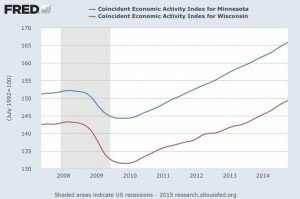 During the Great Recession, our state performed in a stronger manner.
During the Great Recession, our state performed in a stronger manner.
This is pretty strong data. Mr. Tosto goes on to look at the why behind this difference.
Health, education jobs
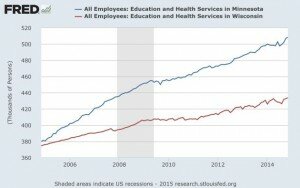 While it isn’t the complete reason Minnesota is performing more strongly, our health care industry is stronger and “continues to drive Minnesota’s post-recession success.” He goes on to state, “Hard to believe that 10 years ago Minnesota and Wisconsin had nearly an equal number of health and education jobs.” By November, 2014, Minnesota outpaced Wisconsin by 74,000.
While it isn’t the complete reason Minnesota is performing more strongly, our health care industry is stronger and “continues to drive Minnesota’s post-recession success.” He goes on to state, “Hard to believe that 10 years ago Minnesota and Wisconsin had nearly an equal number of health and education jobs.” By November, 2014, Minnesota outpaced Wisconsin by 74,000.
Unemployment rate
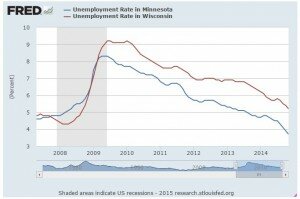 While this is a statistic that has “issues”, according to Mr. Tosto “it is widely followed and it serves as another reminder of how Minnesota has recovered and Wisconsin has not.
While this is a statistic that has “issues”, according to Mr. Tosto “it is widely followed and it serves as another reminder of how Minnesota has recovered and Wisconsin has not.
As you look at this chart, you can see that as of October, 2007, both states had comparable unemployment rates.
Minnesota catching up to Wisconsin in total jobs
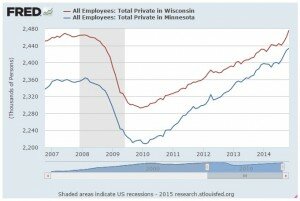 Minnesota has fewer people that Wisconsin. So, you’d assume Wisconsin would have more jobs than our state. But, that’s changing (and, Mr. Tosto points out that’s not because Minnesota is adding more government jobs).
Minnesota has fewer people that Wisconsin. So, you’d assume Wisconsin would have more jobs than our state. But, that’s changing (and, Mr. Tosto points out that’s not because Minnesota is adding more government jobs).
“At the start of the recession, Wisconsin had about 108,000 more private sector jobs than Minnesota. Minnesota has closed that gap dramatically in the recovery. It’s about 42,000 as of November (2014) and was as low as 31,00 in September (2014).”
“It will not be surprising to see Minnesota eclipse Wisconsin in a few years. As the graph above shows, Minnesota recovered its pre-recession private sector jobs nearly two years ago. Wisconsin recovered two months ago.”
GDP muscle
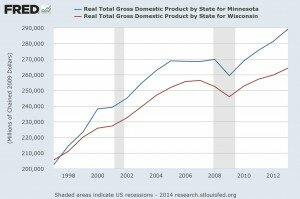 Minnesota’s gross domestic product is also outperforming Wisconsin’s. Our real GDP was $17.4 billion more than Wisconsin in 2008. By the end of 2013, we’d widened that gap to $25 billion.
Minnesota’s gross domestic product is also outperforming Wisconsin’s. Our real GDP was $17.4 billion more than Wisconsin in 2008. By the end of 2013, we’d widened that gap to $25 billion.
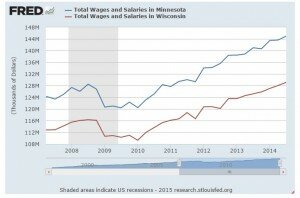 Let’s look at the chart for total wages and salaries by state.
Let’s look at the chart for total wages and salaries by state.
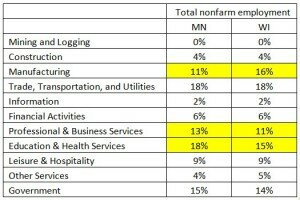 The table in this article is include here, too. It shows up the job breakdown by state as of October, 2014. It shows that “essentially, Minnesota has an advantage over Wisconsin in key growth sectors — education, health services and professional and business services.”
The table in this article is include here, too. It shows up the job breakdown by state as of October, 2014. It shows that “essentially, Minnesota has an advantage over Wisconsin in key growth sectors — education, health services and professional and business services.”
You can read the full article here.
Minnesota eonomic success · MN vs. WI · Wisconsin econonmic problems
 When Gov. Dayton took office in 2011, he promised to “build a Better Minnesota.” Check out the list below sent out by Rep. Joe Atkins (DFL-Inver Grove Heights) to see how the state ranks nationally in a number of important areas.
When Gov. Dayton took office in 2011, he promised to “build a Better Minnesota.” Check out the list below sent out by Rep. Joe Atkins (DFL-Inver Grove Heights) to see how the state ranks nationally in a number of important areas.
And if Gov. Dayton is able to make the investments in education and transportation he outlined in his State of the State April 9, we’ll live in an even Better Minnesota.
EMPLOYMENT. The state’s 3.7 percent unemployment rate is the 5th best in the country, compared to the national average of 5.5 percent, according to the Bureau of Labor Statistics. Like in other states, however, some of the new jobs are coming with limited hours and benefits. Dakota County’s unemployment rate is 3.2 percent.
BUSINESS CLIMATE. For the second year in a row, Minnesota cracked Forbes list of the Top 10 States for Business. Until two years ago, it had been quite a while since we made the Top 10.
SCHOOLS. Minnesota has the highest average ACT scores in the country and ranks second nationally with over 91 percent of residents possessing at least a high school degree. Several local high schools also rank among the best in the nation. But states like Minnesota and Connecticut with high test scores among white students also have the widest achievement gap compared with students of color.
COLLEGE. The State is home to some of the nation’s best colleges and ranks in the top 10 for college graduates and graduation rates, but we also rank in the top 10 for saddling students with loans – an average of over $28,000 per student.
INCOME. We rank 11th nationally with respect to median income. (more…)
10
When Sen. Hann Speaks, Check the Facts
Posted by SD48 DFL Communications Team in David Hann, Issues, News, SD48 GOP
 Our current SD48 Senator and friends held a presser before the April 10 State of the State Address announcing a new “Family Surplus” tax cut. We know whenever we read and hear Republican Orwellian language, it’s important to check the facts.
Our current SD48 Senator and friends held a presser before the April 10 State of the State Address announcing a new “Family Surplus” tax cut. We know whenever we read and hear Republican Orwellian language, it’s important to check the facts.
During his remarks about how awful things have been under Democratic control. We’ve done multiple posts about how Minnesota has outperformed our neighbor to the East, which has been under the kind of Republican control Sen. Hann wants to impose.
But, back to this new tax cut bill. Once again, it’s a percentage across the board on income taxes. Why is that an issue? It benefits those at the top yet again. The Uptake has done a great post on this that includes the video of the conference. Here’s their findings:
- only the progressive (affecting those who are more well off) income tax is included
- someone making $50,000 annually would save $250
- someone making $500,000 annually would save $2,500
- the top 1% of the economy has enjoyed substantially more robust economic recovery from the Republican Great Recession than the 99% of the economy
- more regressive taxes (affecting those who aren’t as well off) like property taxes and sales taxes are, for some reason, not included in the bill he’s carrying
Why are we pointing this out? The Minnesota Tax incidence Study shows the poor and middle class pay 29.9% of their income in state taxes. The highest income bracket? Those folks pay 9.6% of their income. That’s why Sen. Hann always wants to talk percentages and not real money.
You can see the full post here.
David Hann · GOP warn on the middle class · MN vs. WI · Orwellian language · sd48 · Sen. Hann · Senate District 48 · top 1%
 DFL48
DFL48